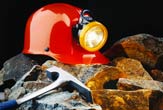Miners Face Health Risks, Even on Good Days

For the 33 trapped Chilean miners potentially facing months in crammed quarters, their immediate health may be threatened by the air quality in the chamber and the limited ability to move, which can lead to blood clots. But even without such catastrophes, miners contend with many daily health dangers from working around dust, heavy metals, hazardous gases, fumes and loud noises.
Listed as the most dangerous industry for workers until 2001, mining is now outranked by industrial fishing, roofing and aircraft-related occupations, among others, according to the U.S. Bureau of Labor Statistics.
The U.S. Mine Safety and Health Administration (MSHA) attributes this improvement to the mining industry's increasing "culture of prevention," which includes stronger regulations, safer machinery and more education and training initiatives in the last 25 years.
Still, miners' chances of dying from explosions, cave-ins and equipment accidents are ever-present, and many chronic and fatal conditions are linked to their toxic work conditions.
"There's no question mining is a dangerous occupation, but it doesn't have to be unsafe," said Joseph Sbaffoni, director of Pennsylvania's Bureau of Deep Mine Safety. "Our culture has changed to the point where it's not acceptable to get hurt or killed on the job, so we've made regulations to help prevent it."
"If you just do things the way you're supposed to," Sbaffoni said, "there's a good chance of finishing out a long career in the mining industry, and you can look forward to a good retirement."
In the 14,500 mines registered in the United States, a record-low 34 miners of the nation's 352,600 died on the job in 2009. Compare that with annual deaths from mining accidents before the 1990s, which are estimated at an average of 1,500, according to the MSHA.
Sign up for the Live Science daily newsletter now
Get the world’s most fascinating discoveries delivered straight to your inbox.
Similarly, the MSHA documented 11,800 work-related injuries among American miners from 2006 to 2007 (the most recent year for which statistics are available), down from the 27,524 work-related injuries that the industry saw each year during the late 1980s.
What working conditions present the biggest health dangers? According to the MSHA, they include exposure to:
- Dust: Very fine mineral dust particles from blasting and drilling can accumulate in the lungs, causing a disease called pneumoconiosis. An irreversible, disabling form of this disease called silicosis can occur when a miner inhales excessive amounts of crystalline silica, or quartz. Black lung disease, which can strike coal miners, is another form. Pneumoconiosis can cause scarring of the lungs called fibrosis.
- Radon: A radioactive, odorless gas, radon is associated with several types of underground mining. Long-term exposure can cause lung cancer.
- Welding fumes: These fumes consist of vaporized molten metal, and chronic overexposure can lead to respiratory tract irritation, systemic poisoning and pneumoconiosis.
- Mercury: A heavy metal present in about 25 organic mineral compounds found in mines (depending on that particular mine), workers can inhale, swallow or absorb mercury through their skin. Even exposure to small quantities over time can lead to severe poisoning. Symptoms of mercury poisoning include weakness, mouth ulcers, bleeding gums and loose teeth, tremors, nausea, abdominal pain, headaches, diarrhea and cardiac weakness.
- Noise: Mining is a noisy process, and unfiltered noise emanating from equipment, such as drills, crushers and engines, can lead to temporary or permanent hearing loss, speech interference and eardrum rupture.
- Heavy loads: Back injuries from lifting and shoveling as well as slips and falls account for about 25 percent of mining injuries that result in lost time from work.
Modern safeguards – including ventilation systems, respirators and ear protectors – are mandated to reduce or eliminate exposure to all of these risks, greatly lowering injuries or fatalities from the levels recorded in the late 20th century, according to the MSHA.
Additionally, black lung disease, which can be fatal, has nearly been eradicated, Sbaffoni said.
However, miners are "always exposed to moving machinery, roof falls, explosions and fires," said Jack Spadaro, a mine safety and health expert in Hamlin, W. Va., and former instructor at West Virginia University's School of Mines. "Certainly there are variations depending on whether they work in a coal mine, metal or non-metal mine, but overall the dangers are pretty much the same."
Sbaffoni said he likens the miners in the current Chilean cave-in, which occurred Aug. 5 in a copper and gold mine, to "people in a submarine. As long as they're provided food, water and communications, I feel they'll be successful in rescuing them."









